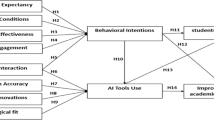Abstract
This paper examines the effect of a computer-assisted career guidance program in South Korean secondary schools. The program used for this study was developed by one of the paper’s co-authors, Young-Hye Kim, based on Harrington & O’Shea’s Career Decision-Making system. MVS (My Vocational Situation) is used for pre-post test. The t-test results indicate that there are some meaningful differences between control and experimental groups on the 9th and the 11th graders in South Korea. There appeared to be gender and age influences on the degree of the effect.
Similar content being viewed by others
References
Amatea, E. S. (1989).Brief strategic intervention for school behavior problems. San Francisco: Jossey-Bass.
Betz, N. E. & Hacket, G. (1986). Applications of self-efficary theory to understanding career choice behavior.Journal of Social and Clinical Psychology, 4, 279–289.
Brown, D. (1987). The status of Holland’s theory of vocational choice.Career Development Quarterly, 36, 13–23.
Cade, B., & O’Hanlon, W.H. (1993).A brief guide to brief therapy. New York: W.W. Norton.
Chang, D. O., Kim, C. K., Park, K. A., & Kim J. H. (1996).Career counseling for adolescents. Seoul: The communication square for adolescents.
de Shazer. S. (1988).Clues: Investigating solutions in brief therapy. New York: Norton.
Fisch, R., Weakland, J. H., & Segal, L. (1982).The tactics of change: Doing therapy briefly. San Francisco: Jossey-Bass.
Fukuyama, M. A., Probert, B.S., Neimeyer, G.S., & Metzler, A.E. (1988). Effects of DISCOVER on career self-efficacy and decision making of undergraduates.The Career Development Quarterly, 37, 56–62.
Ginzberg, E., Ginzberg, S.W., Axelrad, S. & Herma, J.L. (1951).Occupational choice: An approach to a general theory. New York: Columbia University Press.
Harrington, T. F., & O’Shea A. J. (1992).Career decision-making system revised Circle Pines, MN. American Guidance Service.
Harris-Bowlsbey, J. (1991).The respective roles of the counselor and the computer in the career development process. Presented at the International Association of Educational and Vocational Conference, September, Lisbon, Portugal.
Havighurst, R. J. (1972).Developmental tasks and education, 3rd ed. NY: David McKay
Holland, J. L. (1992).Making vocational choices: A theory of vocational personalities & work environments (2ed.). Odessa, FL: Psychological Assessment Resources.
Hoyt, M. F., Rosenbaum R., & Talmon, M. (1992). Planned single-session psychotherapy. In S.H. Budman, M.F. Hoyt, & S. Friedman (Eds.),The first session in brief therapy (pp.59–86). New York: Guilford Press.
Katz, M. R. (1993).Computer-assisted career decision making. Hillsdale, NJ: Erlbaum.
Kim, C. K. & Kim, H. O. (1993).Career education and career counseling. Seoul: KeonKuk University Press.
Kim, H. T. (1989).A study on adolescents’ identity development and its measurement. Doctoral dissertation: ChungNam University.
Kim, T. H. (1990).The relationship between cultural identity development and vocational preferences of Korean-American adolescent students. Doctoral dissertation: Syracuse University.
Kim, Y. H. (1997).Development of a computer-assisted career guidance program and its effects. Doctoral dissertation: WonKwang University.
Littrell, J.M., Malia, J. A., & Vanderwood, M.C. (1995). Single-session counseling in a high school.Journal of Counseling and Development, 73, 451–458.
Luzzo, D. A. & Pierce, G. (1996). Effects of DISCOVER on the career maturity of middle school students.The Career Development Quarterly, 45, 170–172.
Marcia, J. E. (1989). Identity and intervention.Journal of Adolescence, 12, 170–172.
O’Hanlon, B., & Wilk, J. (1987).Shifting contexts: The generation of effective psychotherapy. New York: Guilford Press.
Reardon, R., & Loughead, T. (1988). A comparison of paper-and-pencil and computer version of the Self-Directed Search.Journal of Counseling and Development, 67, 249–252.
Ross, T. J., & Spencer, F. (1988). Reliability and utility of MVS for a psychiatric population.The Career Development Quarterly, 37, 70–77.
Seo, B. Y. (1980). Comparison of identity development between Korean and West German adolescents,KwangJang’ 80(7), 45–50.
Wiggins, J. D. (1987). Effective career exploration programs revised.The Career Development Quarterly, 35(4), 297–303
Wrenn, C. G. (1988). The person in career counseling,The Career Development Quarterly, 36, 337–343.
Author information
Authors and Affiliations
Rights and permissions
About this article
Cite this article
Kim, TH., Kim, YH. The effect of a computer-assisted career guidance program on secondary schools in Korea. Asia Pacific Educ. Rev. 2, 111–118 (2001). https://doi.org/10.1007/BF03024938
Received:
Revised:
Accepted:
Issue Date:
DOI: https://doi.org/10.1007/BF03024938




